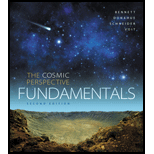
The correct option which describes the changes that would exist in solar system if frost line were farther out.
Answer to Problem 1QQ
Option (B) Jupiter would not exist.
Explanation of Solution
Introduction:
The frost line represents the transition between the inner hot region of solar system to outer cool outer region.
The different region of solar system has different temperature. In the inner region of the solar system temperature is too hot therefore hydrogen and other gases cannot condense to ice. The dense rocky and metallic materials exist in the inner of solar system. Due to high temperature most of the gases in the outer region of solar system.
The frost line is the distance from the center of the solar nebula where gases and interstellar dust particle condensed to form a solid ice. If frost line is farther apart then gases compounds and icy planetesimals cannot condensed to form a massive object many times bigger than Earth. Thus, Jupiter would not exist.
Conclusion:
Thus, if frost line is farthest apart then icy planetesimals are not able to grow like a massive planet like Jupiter. So, the correct option is B.
Want to see more full solutions like this?
Chapter 4 Solutions
The Cosmic Perspective Fundamentals (2nd Edition)
- Earlier in this chapter, we modeled the solar system with Earth at a distance of about one city block from the Sun. If you were to make a model of the distances in the solar system to match your height, with the Sun at the top of your head and Pluto at your feet, which planet would be near your waist? How far down would the zone of the terrestrial planets reach?arrow_forwardYou are making a scale model to visualize the relative sizes of the planets in our solar system. The scale of the model is: 1 cm = 2000 km. The radius of Saturn is 60,000 km. At what radius will Saturn appear on your scale model?arrow_forwardQuestion #4: According to the nebular theory, which planet is most likely to be gaseous rather than rocky? A. Venus, because it is the warmest planet and so is more likely to be gaseous B. Mercury, because planets closer to the solar nebula are more likely to be made of gas, like the nebula C. Earth, because the atmosphere consists of nitrogen, oxygen, and other gases, so it is a gaseous planet D. Neptune, because as the planets get farther from the solar nebula, their composition is more icy and gaseous e Education TM Inc. RK12arrow_forward
- In the classic 1913 science-fiction novel At the Earth’s Core, by Edgar Rice Burroughs, explorers discover that the earth is a hollow sphere and that an entire civilization lives on the inside of the sphere. Would it be possible to stand and walk on the inner surface of a hollow, nonrotating planet?arrow_forwardAccording to the nebular theory, which planet is most likely to be gaseous rather than rocky?arrow_forwardThe diameter of the Sun is 865,380 miles across while Saturn's diameter is 72,368 miles across. The Sun is _____times bigger than Saturn (give whole number as your answer!). If we could shrink Saturn down to a size of a cherry (diameter is 1 inch across), then Sun would be as big as ______. Use one of the following objects as your answer. Watermelon (average size is 12 inches across) Basketball (average size is 9.5 inches across) Average Halloween pumpkin (average size is 15 inches across) Pumpkin at the Puyallup fair (average size is 40 inches across)arrow_forward
- Which of the following is true in our solar system? 1. The planets travel in a circular path, with the sun being in the very center. 2. The planets travel in an elliptical path, with the sun being in the very center. 3. The planets travel in an elliptical path, with the sun at one of the focus points. 4. The planets travel in a helical path, with the sun located along the central axis.arrow_forwardThe light a planet receives from the Sun (per square meter of planet surface) decreases with the square of the distance from the Sun. So a planet that is twice as far from the Sun as Earth receives (1/2)2=0.25 times (25%) as much light and a planet that is three times as far from the Sun receives (1/3)2=0.11 times (11%) as much light. How much light is received by the moons of Jupiter and Saturn (compared to Earth), worlds which orbit 5.2 and 9.5 times farther from the Sun than Earth?arrow_forwardWhy do we say that Neptune was the first planet to be discovered through the use of mathematics?arrow_forward
- One planet is three times farther from the Sun than another. Will the farther planet take more, less, or the same amount of time to orbit the Sun? Will the closer planet orbit slower, faster, or the same speed? How much longer will the farther planet take to orbit than the closer planet? If the closer planet is located at 10 AU, how far is the farther planet, and what are the two planet's names?arrow_forwardWhich planets axis of rotation is a peculiarity, and why?arrow_forwardAccording to the solar nebula theory, why is Earths orbit nearly in the plane of the Suns equator?arrow_forward

 Foundations of Astronomy (MindTap Course List)PhysicsISBN:9781337399920Author:Michael A. Seeds, Dana BackmanPublisher:Cengage Learning
Foundations of Astronomy (MindTap Course List)PhysicsISBN:9781337399920Author:Michael A. Seeds, Dana BackmanPublisher:Cengage Learning AstronomyPhysicsISBN:9781938168284Author:Andrew Fraknoi; David Morrison; Sidney C. WolffPublisher:OpenStax
AstronomyPhysicsISBN:9781938168284Author:Andrew Fraknoi; David Morrison; Sidney C. WolffPublisher:OpenStax
 Principles of Physics: A Calculus-Based TextPhysicsISBN:9781133104261Author:Raymond A. Serway, John W. JewettPublisher:Cengage Learning
Principles of Physics: A Calculus-Based TextPhysicsISBN:9781133104261Author:Raymond A. Serway, John W. JewettPublisher:Cengage Learning Stars and Galaxies (MindTap Course List)PhysicsISBN:9781337399944Author:Michael A. SeedsPublisher:Cengage Learning
Stars and Galaxies (MindTap Course List)PhysicsISBN:9781337399944Author:Michael A. SeedsPublisher:Cengage Learning





